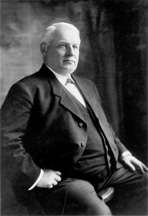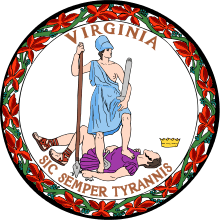Andrew Jackson Montague
| Andrew Jackson Montague | |
|---|---|
 | |
| Member of the U.S. House of Representatives from Virginia's 3rd district | |
|
In office March 4, 1913 – January 24, 1937 At-large: March 4, 1933 – January 3, 1935 | |
| Preceded by | John Lamb |
| Succeeded by | Dave E. Satterfield, Jr. |
| 44th Governor of Virginia | |
|
In office January 1, 1902 – February 1, 1906 | |
| Lieutenant | Joseph E. Willard |
| Preceded by | James Hoge Tyler |
| Succeeded by | Claude A. Swanson |
| 19th Attorney General of Virginia | |
|
In office January 1, 1898 – January 1, 1902 | |
| Governor | James Hoge Tyler |
| Preceded by | Richard C. Scott |
| Succeeded by | William A. Anderson |
| United States Attorney for the Western District of Virginia | |
|
In office 1893–1898 | |
| Appointed by | Grover Cleveland |
| Preceded by | William E. Craig |
| Succeeded by | Thomas L. Alderson |
| Personal details | |
| Born |
October 3, 1862 Campbell County, Virginia |
| Died |
January 24, 1937 (aged 74) Urbanna, Virginia |
| Political party | Democratic |
| Alma mater |
Richmond College University of Virginia |
| Profession | Politician, Lawyer |
Andrew Jackson Montague (October 3, 1862 – January 24, 1937) was an American politician from Virginia. He served as the 44th Governor of Virginia, from 1902 to 1906, and a Congressman from 1912 until his death in 1937. A conservative Democrat, he is best remembered for his support of public education and the Good Roads Movement during his term as governor.
Early life and career
The son of Judge Robert Latane Montague, Andrew Jackson Montague was born in 1862 in Campbell County near Lynchburg, Virginia,[1] his family having fled there to escape the American Civil War. After the war, his family returned to the Tidewater area, and Montague worked on the family farm and attended schools in Middlesex County and Williamsburg. After the death of his father in 1880, Montague left the farm and went to Richmond, Virginia.[2] He received his college education there, from Richmond College (predecessor to the University of Richmond), where he gained a reputation as a skilled orator and debator. After several years as a private tutor, Montague became a law student at the University of Virginia, graduating with a law degree in 1885.[1]
After his graduation from law school, Montague commenced practicing law in Danville, while becoming increasing involved with the local Democratic party. In the presidential election campaign of 1892, Montague developed a relationship with Grover Cleveland, who then appointed Montague in 1893 as the United States Attorney for the Western District of Virginia.[1] Montague held that position five years, until, in 1898, he was elected as the Attorney General of Virginia.[3]
Governor
While serving as attorney general, Montague became increasingly involved with the Virginia Progressive movement, with an emphasis on education reform and disfranchisement of black voters as a way to stem political corruption.[4] Positioning himself as the independent alternative to Senator Thomas S. Martin's political machine, Montague determined to make a run in the upcoming Virginia gubernatorial election. Running on the independent platform, Montague solidly defeated Martin's candidate, Claude A. Swanson, for the Democratic nomination for Governor of Virginia.[5] Montague went on to easily beat Republican candidate J. Hampton Hoge in the general election of 1902, becoming the first Virginia governor since the Civil War who had not served with the Confederate Army.[6] Shortly after Montague's inauguration, and with his support, the Virginia Constitution of 1902 was enacted, with poll taxes and literacy tests that effectively disenfranchised the black vote.[4] Ironically, the new Constitution created a smaller and more easily controlled electorate, thus strengthening the Martin machine.[5]

As governor, Montague's focus was on the progressive agenda, and he gave frequent speeches throughout the state calling for progress toward "good schools" and "good roads". His efforts on behalf of schools resulted in some tangible progress, particularly in terms of increased local funding, longer terms and consolidation of schools. For roads, he pressed for the creation of a state highway commission, which officially came into being two months after he left office.[7] Montague also championed the primary process as a more open way to select political party candidates, and his efforts helped lead to the primary system being adopted for the first time in 1905.[8] However, these accomplishments fell far short of Montague's legislative ambitions, for which he blamed a hostile legislature and the political machine run by his long-time foe, Senator Martin.[9]
In 1905, while still in office as governor, Montague determined to make a run for the United States Senate against the incumbent Martin. Martin and Montague represented the two main factions within the Virginia Democratic party, and their contest would effectively determine which would control Virginia politics.[10] Martin responded to the challenge by publicly embracing Montague's main issues - good schools, good roads and the primary election process. Having minimized the differences between their positions and with a larger political organization,[11] Senator Martin handily won re-election, leaving an embittered Montague to finish out his term as governor.[12]
Election
1901; Montague was elected Governor of Virginia with 58.19% of the vote, defeating Republican John Hampton Hoge, Prohibitionist O.C. Rucker, and Socialists Hugh Motter and John J. Quantz.[13]
Congressman
After leaving office as governor, Montague served as the dean of Richmond College Law School for three years, before returning to the private practice of law in 1909.[3] In 1912, he returned to politics by defeating the Republican incumbent to win the Richmond District seat in the United States House of Representatives, a seat he would retain for almost a quarter of a century.[14]
A supporter of President Woodrow Wilson's internationalist agenda, Montague lost influence when the Republicans took control of Congress in the 1920s. Despite this, and a failed bid to gain appointment to the Supreme Court, Montague was respected by his colleagues, even acquiring the nickname "Judge".[14] In 1926, he was selected by the House as one of the managers to prosecute the impeachment proceedings against Judge George W. English.[3]
In 1934, he purchased Sandwich at Urbanna, Virginia.[15] Montague died in office on January 24, 1937, after winning a narrow election against his first significant opposition in twenty-five years.[16] He is interred in the courtyard of Christ Church in Saluda, Virginia.[17]
Electoral history
- 1912; Montague was elected to the U.S. House of Representatives with 97.58% of the vote, defeating Independent Chase A. Haight and Socialist Labor H. Adolph Muller.
- 1914; Montague was re-elected with 95.81% of the vote, defeating Socialist S.C. Weatherly and Socialist Labor Muller.
- 1916; Montague was re-elected unopposed.
- 1918; Montague was re-elected unopposed.
- 1920; Montague was re-elected with 72.5% of the vote, defeating Republican Walker G. Decourcy, ColR (?) H.H. Price, Independent Republican John L. Grubbs, and Socialist Muller.
- 1922; Montague was re-elected with 90.14% of the vote, defeating Republican Channing M. Ward.
- 1924; Montague was re-elected with 99.97% of the vote, defeating Republican C.B. Jones.
- 1926; Montague was re-elected unopposed.
- 1928; Montague was re-elected with 75.89% of the vote, defeating Republican J.D. Peake and Independents James E. Maynard and Henry W. Anderson.
- 1930; Montague was re-elected with 87.4% of the vote, defeating Independent Republican R. Houston Brett.
- 1932; Montague was re-elected as part of the Democratic slate for Virginia at-large Congressional district.
- 1934; Montague was re-elected with 80.45% of the vote, defeating Republican Roy C. Parks, Socialist Hilliard Bernstein, and Communist William H. Friend.
- 1936; Montague was re-elected with 84.49% of the vote, defeating Republican Charles G. Wilson and Socialist Winston Dawson.
References
- 1 2 3 Tyler, Lyon Gardiner, ed. (1915). Encyclopedia of Virginia Biography. Lewis historical publishing company. p. 10.
- ↑ Larson, William (1982). Edward Younger, ed. The Governors of Virginia, 1860–1978. University Press of Virginia. pp. 159–160. ISBN 0-8139-0920-1.
- 1 2 3 "Biographical Directory of the United States Congress: MONTAGUE, Andrew Jackson, (1862 - 1937)". United States Congress. Retrieved 2007-08-13.
- 1 2 Larson (1982) pp. 160-163
- 1 2 Heinemann, Ronald; Kolp, John; Parent Jr., Anthony; Shade, William (2007). Old Dominion, New Commonwealth: A History of Virginia 1607–2007. University of Virginia Press. pp. 278–279. ISBN 978-0-8139-2609-4.
- ↑ Bellamy, Francis Rufus (1902). "Notable Figures in the Political Field". The Outlook. New York: The Outlook Company. LXX (January–April, 1902): 23. Retrieved 2009-01-05.
- ↑ Larson (1982) pp. 164-165
- ↑ Moger, Allen (1968). Virginia: Bourbonism to Byrd, 1870–1925. University Press of Virginia. pp. 203–206. ISBN 0-8139-0182-0. OCLC 435376.
- ↑ Moger (1968) pp. 207-208
- ↑ Moger (1968) p. 206
- ↑ Moger (1968) pp. 210-211
- ↑ Larson (1982) p. 166
- ↑ "Our Campaigns - VA Governor Race - Nov 05, 1901". Retrieved May 1, 2016.
- 1 2 Larson (1982) p. 167
- ↑ R. Latane Montague, IV (December 2007). "National Register of Historic Places Inventory/Nomination: Sandwich" (PDF). Virginia Department of Historic Resources.
- ↑ Larson (1982) pp. 167-168
- ↑ Andrew Jackson Montague at Find a Grave
External links
| Wikimedia Commons has media related to Andrew Jackson Montague. |
- A Guide to the Executive Papers of Governor Andrew J. Montague, 1884–1907 (bulk 1902–1905) at The Library of Virginia
- "There Ain't No Barbecue Like a Montague Barbecue" at Out of the Box: Notes from the Archives at the Library of Virginia
| Political offices | ||
|---|---|---|
| Preceded by James Hoge Tyler |
Governor of Virginia 1902–1906 |
Succeeded by Claude A. Swanson |
| United States House of Representatives | ||
| Preceded by John Lamb |
Member of the U.S. House of Representatives from Virginia's 3rd congressional district 1913–1933 |
Succeeded by District abolished Himself after district re-established in 1935 |
| Preceded by District re-established John S. Wise before district abolished in 1885 |
Member of the U.S. House of Representatives from Virginia's At-large congressional district 1933–1935 |
Succeeded by District abolished |
| Preceded by District re-established Himself before district abolished in 1933 |
Member of the U.S. House of Representatives from Virginia's 3rd congressional district 1933–1937 |
Succeeded by Dave E. Satterfield, Jr. |
